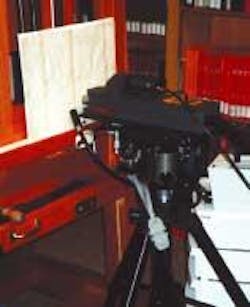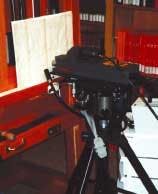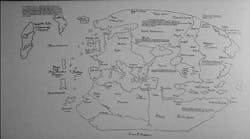Raman study suggests Viking map is a forgery
The Vinland map, a famous 15th century world map, may be a clever forgery—and therefore was not likely to have been drawn by Vikings some 50 years before Christopher Columbus sailed the ocean blue in 1492, say scientists at University College London (London, England). An analysis using Raman spectroscopy confirmed the faint lines on the controversial map contain ink that was not available before 1917 (see figure).1
The Vinland map came to light in 1957, discovered bound in a 15th century text called The Tartar Relation. Scientists have since staked their reputations on proving or disproving the authenticity of the Vinland map, which shows a large island west of Greenland labeled, "Vinilanda Insula." If genuine, the map would support Icelandic folklore that claims western Europeans were at least aware of some portion of North America before Columbus.
null
null
Over the past 10 years, the University College London group has applied Raman microscopy to a variety of ancient artwork and manuscripts. In collaboration with the spectroscopy products division of Renishaw (Gloucestershire, England) and the Beinecke Rare Book and Manuscript Library at Yale University (New Haven, CT), doctoral student Katherine Brown and professor of chemistry Robin Clark borrowed the map and the Tartar Relation for in situ analysis with Raman microprobe spectroscopy. Brown identified 14 target areas on the map on the basis of pigment density, including some from plain parchment, from which to take spectra to look for accidental contamination from domestic paints.
The probe head of the Raman system was controlled remotely using a joystick to locate and view targets on a computer monitor. The Raman analyzer used a 632.8-nm laser with up to 8 mW of power. The fiberoptic probe scanned the targets with a 5-µm-diameter spot over accumulation times up to 800 s.
The lines of ink on the map consisted of a yellowish line and an overlying layer of faded black specks. The black ink on the map was primarily composed of carbon with occasional traces of the mineral anatase. From the yellow lines, a weak, broad band at 398 cm-1 was evidence of anatase, a rare form of titanium dioxide. The team concluded that the anatase on the map in significant quantities originated from the yellow layer underneath the black carbon ink. The parchment itself did not show traces of anatase, precluding the possibility of environmental anatase tainting. Moreover, the ink on the Tartar Relation was indicative of iron gallotannate ink, which, unlike anatase, is indicative of mid-15th century documents.
Anatase, the key
Yellowing is a common effect with the iron-gallotannate inks used in medieval times. This ink, however, was carbon based, so the apparent yellowing should not have occurred, says Brown. Further, anatase is a rare form of titanium dioxide that occurs naturally only in black, blue, or dark brown. But yellow anatase requires a complicated production process not accomplished in manufacturing until the early 20th century. In 1917, first yellow and then white anatase was patented and produced industrially for the first time.
Could ancient Scandinavian or European ink makers have produced yellow ink containing anatase? Jacqueline Olin, research associate at the Smithsonian Center for Materials Research and Education (Washington, DC) and long-time Vinland map advocate thinks so. "The presence of anatase does not preclude the ink from being medieval," she says. "There have not been many studies of medieval inks. One important question is whether precipitated anatase with an exact matching crystal size could have been in medieval inks. There is more work to be done before a decisive conclusion can be made."
If the map were a forgery, it may be that the artist first drew yellow lines, later tracing over them with carbon ink to simulate the appearance of a degraded iron-gallotannate ink, says the London team. This is the conclusion of many experts and scientists in the longstanding, complicated debate.2 "The Vinland map, along with the Turin Shroud, are fake . . . masterpieces of art . . . [with] obvious intent to fool," says Walter McCrone, chemist and longtime Vinland map skeptic.2
While the debate on the map continues, archeological evidence in Newfoundland, Canada, indicates that the Vikings reached North America centuries before Columbus. Nevertheless, the resolution will place the Vinland map as either an important historical document or a painstaking work of art.
REFERENCES:
- K. Brown and R. Clark, Anal. Chem., 3658 (June 2002).
- http://www.mcri.org/vm_shroud_update.html


